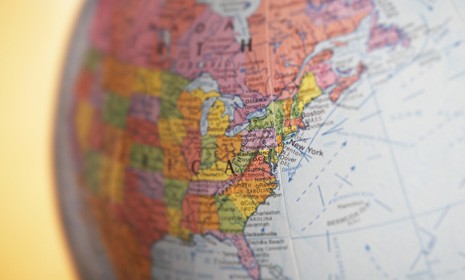'Amasia': The supercontinent of the future?
Hundreds of millions of years in the future, humans will be able to walk from North America to China by foot — at least according to a new theory from Yale

It appears that North America and Asia are on a collision course to link up as a single, unified supercontinent in the next hundred million years, according to new research from Yale geologists — but not in quite the same way other scientists have predicted. The findings are published in the journal Nature. Here's a quick look at the dominant landmass of the distant future, "Amasia."
What are supercontinents?
They're extraordinarily large landmasses that scientists hypothesize existed hundreds of millions of years ago. Experts can pinpoint at least three supercontinents in Earth's history, says Alan Boyle at MSNBC: "Pangaea, which goes back 300 million years; Rodinia, which dates to roughly 1 billion years ago; and Nuna, which existed about 1.8 billion years ago."
The Week
Escape your echo chamber. Get the facts behind the news, plus analysis from multiple perspectives.

Sign up for The Week's Free Newsletters
From our morning news briefing to a weekly Good News Newsletter, get the best of The Week delivered directly to your inbox.
From our morning news briefing to a weekly Good News Newsletter, get the best of The Week delivered directly to your inbox.
How are they created?
The seven continents we know today are moving (and always have been), thanks to slow-shifting tectonic plates underneath the planet's surface. "The land masses of the earth are constantly moving as the earth's tectonic activity occurs," says Neil Bowdler at BBC News. The plates creep underneath the planet's surface and are responsible for creating areas like "the Mid-Atlantic Ridge, where Iceland has formed, and areas such as that off the coast of Japan, where one plate rides over another."
What is new about this theory on Amasia?
Geologists first predicted the formation of Amasia in the 1990s. Looking at the geology of mountain ranges, they figured the next supercontinent would come together with either the Pacific closing up, or the Atlantic (which would put a supercontinent right where Pangaea was). But the Yale researchers examined the magnetism of rocks to figure out how they had moved around the globe over time, and concluded that a supercontinent forms at a 90-degree angle from the one that preceded it. So while the older theories put Amasia along the equator, the Yale model suggests that Asia and the Americas will intersect over the Arctic, at a 90-degree angle to where Pangaea was. In theory, "someone could walk from the U.S. to China and say, 'Hi, neighbor.'"
A free daily email with the biggest news stories of the day – and the best features from TheWeek.com
And what of the remaining continents?
Eventually, Europe, Africa, and Australia are all predicted to join the giant landmass, with only Antarctica left out. As for humans? Says Yale geologist Ross Mitchell: "I would be quite surprised if humans lasted long enough to see the next supercontinent come to fruition. The truth is that none of the present scientific community will be around 100 million years from now to test these models."
Sources: BBC News, Discovery News, MSNBC
-
 Trump HHS slashes advised child vaccinations
Trump HHS slashes advised child vaccinationsSpeed Read In a widely condemned move, the CDC will now recommend that children get vaccinated against 11 communicable diseases, not 17
-
 Hegseth moves to demote Sen. Kelly over video
Hegseth moves to demote Sen. Kelly over videospeed read Retired Navy fighter pilot Mark Kelly appeared in a video reminding military service members that they can ‘refuse illegal orders’
-
 Delcy Rodríguez: Maduro’s second in command now running Venezuela
Delcy Rodríguez: Maduro’s second in command now running VenezuelaIn the Spotlight Rodríguez has held positions of power throughout the country